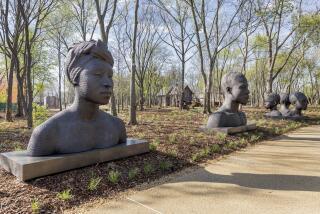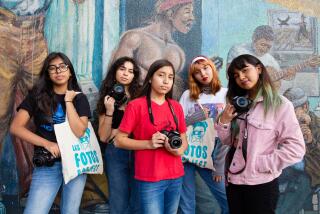Gut-wrenching photo evidence from Brown vs. Plata in ‘Prison Obscura’
The United States is a world leader in a lot of areas. Perhaps most disconcerting is our dominance in the area of incarceration. More than 2 million people currently reside in America’s prisons and jails, a figure that has more than quadrupled since 1980, due to mandatory sentencing laws, among other factors. It is an area of our society that has experienced explosive growth, yet it is one that most Americans rarely see.
A new photography exhibition at the Clark Humanities Museum at Scripps College in Claremont seeks to remedy that. Organized by independent journalist and curator Pete Brook, “Prison Obscura” brings together nine projects that examine aspects of life in U.S. prisons, including portraits of female inmates in Montana and a digital project that gathers aerial views of prisons from Google Maps.
Brook, who writes the Prison Photography blog, wasn’t looking to just stage a show of straight documentary photography — showing men in their cells or blue-clad inmates in a prison yard.
“I wanted it to be about storytelling,” he explains. “The camera is often an extension of a prison’s power, so when you look at photos from inside a prison, what you are often seeing is that power. I wanted projects that went deeper, that involved prisoners, that required some level of commitment from the photographer. And, alternatively, to look at photographs that weren’t made by named photographers at all, but by internal processes, legal teams or satellites.”
As a result, the exhibition includes photography about some curious prison phenomena. There is a riveting series of images from L.A. photographer Alyse Emdur, who chronicles the bright landscape murals often used as photographic backdrops in prisoner visitation rooms. The whole effect couldn’t be more surreal: Emdur captures images of idyllic mountain landscapes and wild seascapes amid the severe reality of prison architecture.
As part of the project (which was published in book form two years ago), she had prisoners submit photos of themselves standing before these murals, which feature a variety of subjects, including Japanese gardens and a cozy living room with a brightly illuminated Christmas tree. These are displayed alongside Emdur’s own oversized photographs. All together, it’s a highly intriguing record of an unusual art-making tradition.
“There’s a small history of mural painting in prison, like the San Quentin chow-hall murals,” says Brook. “But these are different. They emerged most prominently in the years of mass incarceration. And it’s interesting to see how quickly that happened.”
Other photographic projects connect prisoners with elements from their past. Photographer Kristen S. Wilkins created a series of portraits of women incarcerated in Montana. These are paired, as diptychs, with images of things the women miss most.
Photographer Mark Strandquist explores a similar concept, but takes a different approach: his snapshot-sized photographs of the places prisoners long for are displayed alongside letters from the prisoners themselves. The latter are reproduced as postcards, which the viewer is invited to take.
“Every time I feel the walls closing in on me I stare out my window,” writes one inmate, “and its like a breath of fresh air, because right out side my window is my moms house and it’s so big bright and beautiful.”
“It’s interesting, “ Brook says, “because a lot of them reflect on a time before they were fallen. They reflect on childhood and, particularly, their mothers.”
Various projects use outside sources and collaborators. Artist Josh Begley harvested aerials of prison architecture using Google Maps, while Steve Davis gave cameras to youths incarcerated in juvenile facilities in Tacoma, Wash., and displays the results. For his series “Take a Picture, Tell a Story,” Robert Gumpert takes elegant black-and-white portraits of inmates, then asks them to tell him a story -- any story. These tales span the range of human existence, including profound investigations into what has meaning and funny anecdotes about prison food.
Perhaps most gut-wrenching is the series of pictures generated as evidence for the case of Brown vs. Plata, a class-action lawsuit against the state of California, related to issues of access to medical care and serious overcrowding in the state’s prisons. The case made it all the way to the U.S. Supreme Court, which ordered California to release 46,000 inmates in order to relieve conditions.
Brook followed the case for years and was able to get the images through the law firm that led the suit. Very simply installed on a wall in the gallery, the images show conditions of intense overcrowding (row after row of triple-bunks packed into large halls) and group therapy sessions in which prisoners sit in individual cages as they meet with a counselor.
“In the super maxes, the prisoners aren’t sitting on couches,” Brook says. “They sit in a semi-circle in cages with a therapist at the center. Sometimes there isn’t even a therapist. They’re just sitting in a half moon watching a TV set that plays a video.”
Juliet Koss, who is the director of the Humanities Institute at Scripps, brought the exhibition to the college after seeing it at Haverford College in Pennsylvania.
“I was at Haverford for a weekend conference and someone told me, ‘While you’re here, run across campus and take a look at this show,’” Koss recalls. “I knew right away that I wanted to bring it to Scripps.”
The exhibition, which is installed at the Clark Humanities Museum at Scripps, isn’t simply another art show. It will serve as a tool for students who will employ it as a point of discussion in their courses and seminars.
“It’s aesthetically beautiful and challenging, and it’s didactic without being patronizing,” Koss says of the show. “But it also ties into what we are doing in the [Humanities] Institute. The theme for the semester is ‘silence’ and this was an interesting way of exploring that: of people who have been silenced or the general silence that there is about this topic.”
“Above all,” she adds, “the exhibition gets people thinking about these questions visually and this is important to me, in part because I’m an art historian.”
For the average viewer, however, the show will also provide plenty to consider -- about the nature of incarceration, the frequency with which our society employs it as a tool, and the general invisibility of a system that keeps one out of every 100 Americans behind bars.
“Prison Obscura” is on view at the Clark Humanities Museum through Oct. 17, 1030 Columbia Ave., Claremont, scrippscollege.edu. On Oct. 2, at 4:15 p.m., curator Pete Brook will give a lecture about the exhibition at the college’s Garrison Theater.
More to Read
The biggest entertainment stories
Get our big stories about Hollywood, film, television, music, arts, culture and more right in your inbox as soon as they publish.
You may occasionally receive promotional content from the Los Angeles Times.







